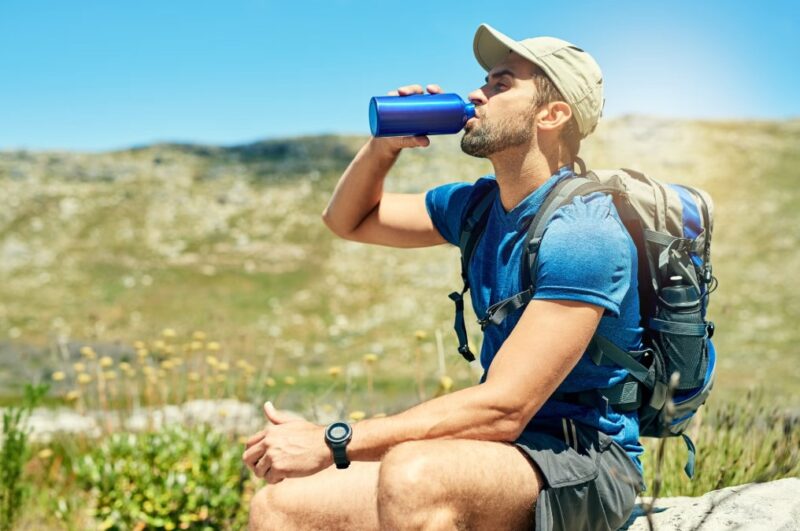By Ethan Lewis
Hikers love to talk about boots and backpacks, but not enough people talk about water. The fastest way to turn a fun day hike into a grind is to underestimate how much you need to drink or bring the wrong bottle for the conditions.
I have made that mistake on hot desert trails more than once, which is why I now pay a lot more attention to my hydration setup and even put together a full guide to the best hiking water bottles I have tested for real trail use on my own site.
This article is the simple version of that experience. No formulas you need to memorize, just a practical hydration strategy that works for most day hikes and keeps you out of trouble.
Why Hydration Matters More Than You Think
Dehydration rarely hits all at once. It creeps in slowly.
On hot or dry hikes you might notice:
- Your pace getting a little slower
- Your mood getting a little shorter
- A light headache starting to build
- A feeling that every small climb suddenly takes more effort
Those are early warning signs. If you ignore them, things can get serious. The Mayo Clinic notes that dehydration can lead to dizziness, confusion, and in extreme heat, heat exhaustion or heatstroke. You do not need to hike in extreme conditions for dehydration to be a problem. A sunny day at moderate temps is enough if you are not drinking regularly.
The good news is that a few simple habits and the right bottle setup prevent most of this.
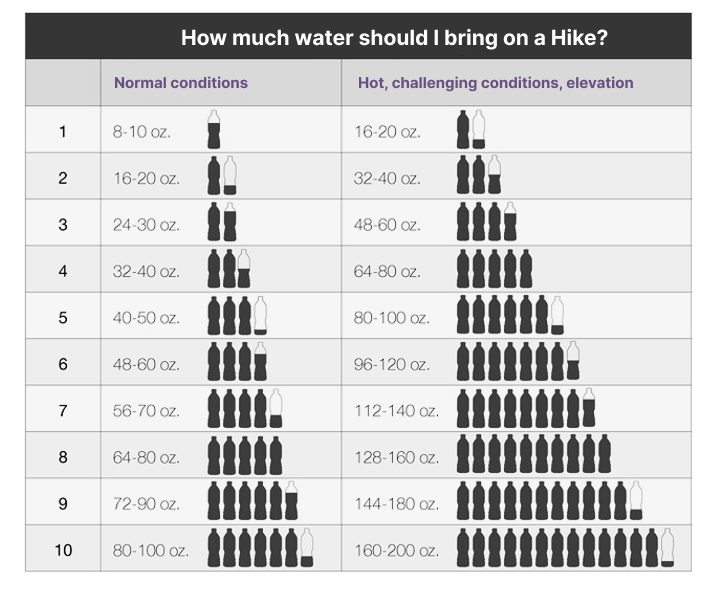
How Much Water Do You Actually Need?
For most day hikes in moderate conditions, a good rule of thumb is:
Plan for about 0.5 liters (around 17 ounces) of water per hour of hiking, and double that in hot weather or at higher altitude.
Examples:
- Easy 2 hour hike in mild weather → ~1 liter
- 4 hour hike on a warm day → at least 2 liters
- 5–6 hour hike with lots of sun exposure → 2.5 to 3 liters
Several national park agencies recommend a similar range, especially in desert or high-elevation areas, where you can lose more water through breathing and sweat than you realize.
If you end the hike with a little extra water, that is a win. If you run dry with miles to go, that is a problem.
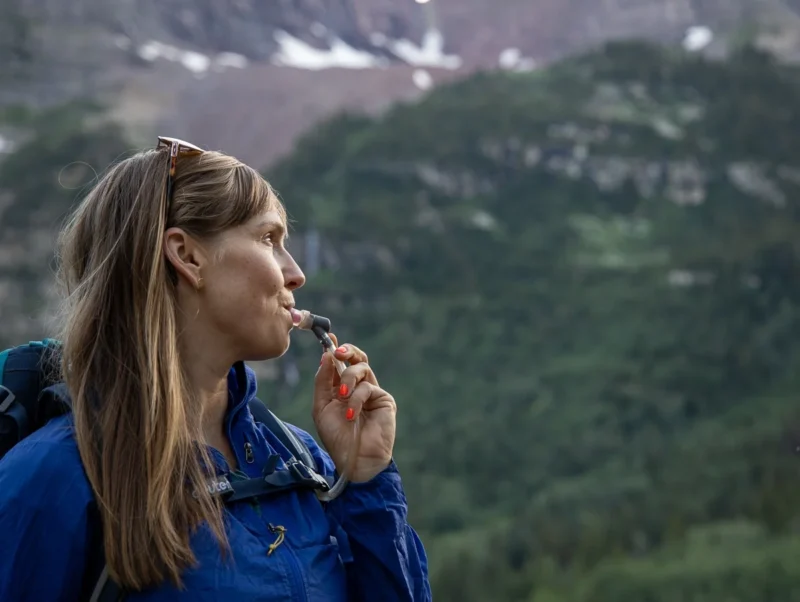
Bottles vs Hydration Bladders – What Should You Use?
Both water bottles and hydration bladders work well, but they shine in different situations.
When Bottles Work Best
In my experience, bottles are the best choice for:
- Beginners and newer hikers
- Short to medium day hikes
- People who like to see how much water is left
- Anyone who wants easy cleaning and fewer parts to break
Bottles are simple. You fill them, screw on the lid, and go. You can also pack different fluids in separate bottles if you want one for electrolytes and one for plain water.
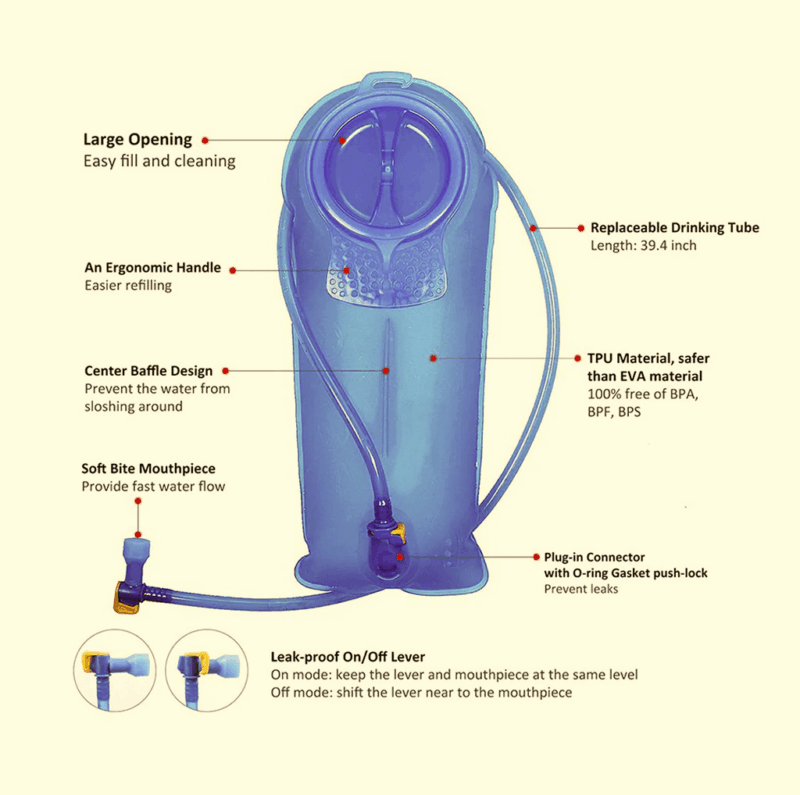
When Bladders Work Best
Hydration bladders are great for:
- Long, steady efforts where you want to sip constantly
- Hikers who already have their system dialed in
- Cold weather trips where hose freeze can be managed
- Backpacking and longer trails with big elevation gain
Bladders encourage frequent sipping because the hose is right there. That can help prevent dehydration, but you have to be willing to maintain and clean them properly.
My Recommendation for Most Day Hikers
If you are still building your hiking habits, I would start with bottles and upgrade to a bladder later if you feel limited. Bottles are easier to understand, easier to clean, and easier to replace if something fails.
Choosing the Right Bottle for Safety and Comfort
A hiking water bottle is not just a convenience item. It is part of your safety kit. Here are the features that matter most on real trails.

1. Leak Protection
If a bottle leaks when stored sideways in your pack, it is not a hiking bottle. Leaks soak spare layers, food, and maps. Worst case, they waste your only water.
Before you take a new bottle on the trail, fill it, close it, set it on its side on a towel, and leave it for a while. If the towel stays dry, that is a good sign.
2. Insulation
Insulation matters more as temperatures rise. In cooler weather, an uninsulated bottle is fine. In summer heat, insulated bottles keep water from becoming lukewarm or hot, which makes it easier to drink enough.
Cold water feels better and often leads to more frequent sips. That alone helps your performance and decision making on the trail.
3. Lid Design and Ease of Drinking
The lid determines how easy it is to drink on the move:
- Flip caps and straw lids make quick sips simple
- Wide mouth lids are great for filling, but awkward to sip from while walking
- Screw tops are reliable, but slower to open and close
If your bottle is annoying to drink from, you will drink less. I noticed this clearly in my own testing. When the bottle required two hands and a full stop, I postponed drinking more often.

4. Grip and Shape
Hands get sweaty, dusty, or cold on many trails. A perfectly smooth bottle can be easy to drop. Slight texturing, a matte coating, or gentle shaping makes a big difference.
I once watched a smooth stainless bottle bounce down a rocky slope after a small slip near a viewpoint. It was a good reminder that grip is not just about comfort. It is about control.
5. Durability
You do not need an indestructible tank for a day hike, but your bottle should survive at least one normal drop onto rock or hard packed dirt.
I have had cheaper bottles crack at the lid after a basic fall. Once that happens, it is useless for hiking. You do not want to discover that halfway through a loop with no water sources.
If you want specific models that passed my trail tests, I keep an updated list of recommended hiking water bottles based on real trail use on my own site, including insulated and non insulated options.
Simple Packing Tips That Make Hydration Easier
A few basic packing habits can make your hydration setup feel much smoother.
- Keep bottles near the top of your pack
So you are not digging for them every time. - Use side pockets if your pack has them
That way you can grab a bottle without taking the pack off. - Protect insulated bottles from direct sun when resting
Shade or inside the pack helps keep water colder longer. - Bring a small electrolytes option on hot days
Tablets, powders, or sports drink mix can help replace salts lost through sweat. - Do a quick mid-hike check
Glance at your bottles halfway through. If you are almost empty already, turn around or shorten the route.
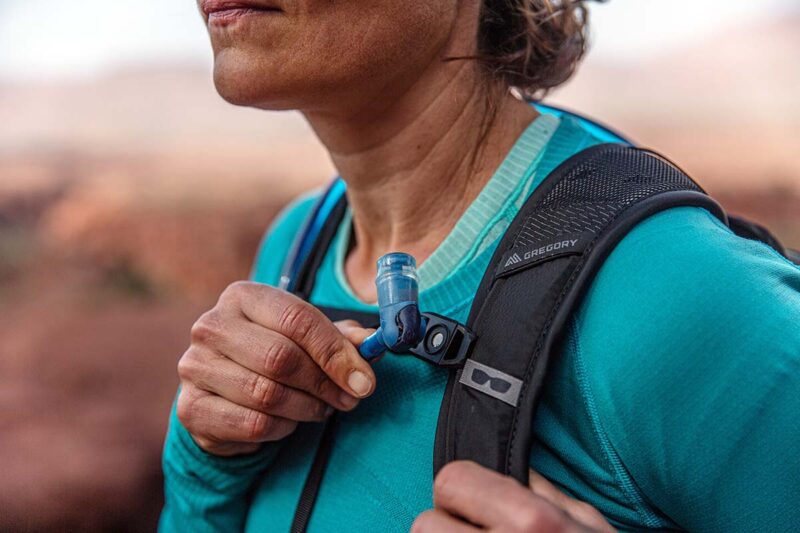
Hydration Timing – How Often Should You Drink?
Think of hydration as a steady drip, not a flood.
Instead of waiting until you feel very thirsty and chugging, try to:
- Take a few sips every 15–20 minutes
- Drink more on long climbs or in exposed areas
- Start hydrated instead of catching up later
Your body handles smaller, more frequent amounts of water better. It also keeps your energy and mood more stable.
Signs You Are Starting to Get Dehydrated
Everyone is a little different, but these are common early signs on the trail:
- Headache or pressure in the temples
- Slower pace without a clear reason
- Feeling unreasonably annoyed or foggy
- Dry mouth that does not go away
- Dark yellow urine on rest breaks
If you notice a couple of these, it is time to slow down, find shade, and drink. In hotter conditions, pair water with some electrolytes and give your body a few minutes before pushing on.
If symptoms get worse or you start to feel dizzy, nauseous, or confused, it is time to turn around and treat it as a real safety issue, not just discomfort.
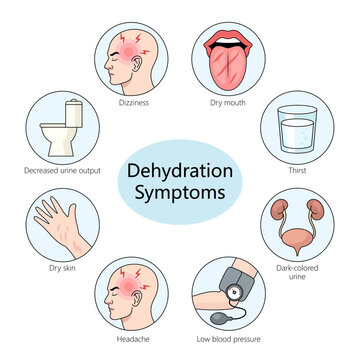
A Quick Hydration Checklist Before You Leave Home
Before you lock the door and drive to the trailhead, run through this simple checklist:
- Do I have enough water for the full hike, plus a little extra?
- Am I using a bottle or bladder that I have already tested for leaks?
- Is my bottle easy to drink from while walking?
- Do I have a backup option if one bottle fails on a longer hike?
- For hot days, did I pack electrolytes or salty snacks?
If you can say yes to those, you are in a good spot.
That’s all!
Hydration is not the most glamorous part of hiking, but it touches everything else. When you drink enough and your bottle system works smoothly, you move better, think more clearly, and actually enjoy the views instead of just grinding toward the car.
You do not need a complicated system. You just need enough water, a reliable bottle that fits your hiking style, and a few habits that keep you sipping steadily throughout the day. Once you dial that in, every other part of the hike gets easier.

